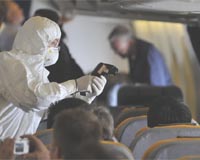| . |  |
. |
Geneva (AFP) June 24, 2009 Swine flu has infected 55,867 people in 109 countries and territories and killed 238 people since late March, the World Health Organisation reported Wednesday in its latest toll. There have been an extra 3,707 new cases and seven more deaths since the last toll released by the UN health agency on Monday, a slower rate of increase than the sharp rise from the previous Friday. In the latest figures Canada experienced the largest increase, of 747 to a total of 6,457, including 15 dead, followed by Australia, up 421 to 2,857, with two dead. Of the seven new deaths, two each occurred in Mexico and Canada, and one each in Australia, the Philippines and the Dominican Republic. The United States remains the worst-hit in the world, with 21,449 cases, 87 of them fatal, followed by Mexico, where the outbreak began in March, on 7,847 with 115 deaths. Britain remains the worst-affected country in Europe. It has recorded 399 additional cases, taking its total to 2,905, including one death.
Argentina reports seven more swine flu deaths The Health Ministry provided no details on the deaths except to say that of the total, four occurred in the city of Buenos Aires and the remainder in the province of Buenos Aires. With the southern hemisphere now in winter, the A(H1N1) virus has spread more broadly in Argentina and neighboring Chile than in most parts of Latin America, making it a closely watched harbinger of the flu season to come in the northern hemisphere. The Health Ministry reported 1,294 confirmed swine flu cases, and said 967 other cases were being tested for the A(H1N1) virus. All but emergency surgeries have been postponed in the Buenos Aires province to keep hospital beds open in case the epidemic worsens, health authorities said.
Four more swine flu deaths in Canada, toll hits 20 The Public Health Agency in Ottawa said there were two new swine flu fatalities in the capital, one of a 52-year-old woman and "an adolescent who had pre-existing chronic health conditions." Health officials in Quebec merely reported "two new deaths." The French-speaking province has recorded 11 of the nation's 20 deaths linked to epidemic. A toll released Monday by Canada's health ministry said there were a total of 6,457 cases of swine flu, including 404 which required hospitalization. Canada is the third worst swine flu-affected country, after the United States, with 87 deaths and nearly 21,500 confirmed cases, and Mexico with 116 deaths and 8,600 infections.
Woman dies of swine flu in Dominican Republic The flu, which first appeared in Mexico in April, has infected 108 people in the Dominican Republic. Spreading through Latin America, the virus has had the biggest impact in the countries of the southern cone of South America where the epidemic is expected to peak in the coming weeks as winter deepens in the southern hemisphere. Argentina has already reported 10 deaths from among 1,213 people infected with the virus, while the toll in neighboring Chile has grown to seven dead from among 4,315 flu cases. Worldwide, the A(H1N1) virus has sickened 52,160 people in 100 countries and territories, causing 231 deaths, according to the latest figures of the World Health Organization.
Mexico reports swine flu 116 deaths, 8,163 infections A total of 8,613 people in Mexico are thought to have contracted the A(H1N1) virus, an increase from figures contained in a press statement last week that cited 113 deaths since June 16 and 7,624 cases of infection since June 18. The latest press release said "very few of the cases involved recent symptoms," and Mexican health officials said this was a sign that the epidemic is on the decline. Mexico is hosting an international summit on swine flu at the coastal resort of Cancun on July 2-3. The director general of the World Health Organization (WHO), Margaret Chan, is expected to attend with experts from around 40 countries. Share This Article With Planet Earth
Related Links Epidemics on Earth - Bird Flu, HIV/AIDS, Ebola
 Indonesia concerned Australians bringing swine flu to Bali
Indonesia concerned Australians bringing swine flu to BaliJakarta (AFP) June 24, 2009 Indonesia expressed concern Wednesday that Australian tourists are bringing swine flu into the country via the resort island of Bali, as it confirmed its first two cases of the virus. Health Minister Siti Fadilah Supari said she was "very worried" that Australians who flock to Bali's famous surf beaches would spread the virus in a country that had so far avoided the worst of the pandemic. ... read more |
|
| The content herein, unless otherwise known to be public domain, are Copyright 1995-2009 - SpaceDaily. AFP and UPI Wire Stories are copyright Agence France-Presse and United Press International. ESA Portal Reports are copyright European Space Agency. All NASA sourced material is public domain. Additional copyrights may apply in whole or part to other bona fide parties. Advertising does not imply endorsement,agreement or approval of any opinions, statements or information provided by SpaceDaily on any Web page published or hosted by SpaceDaily. Privacy Statement |